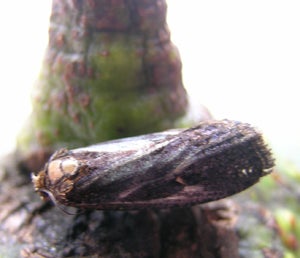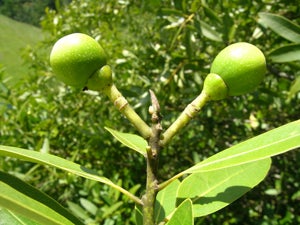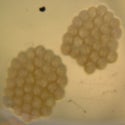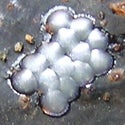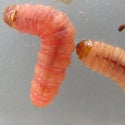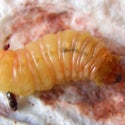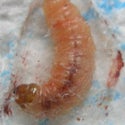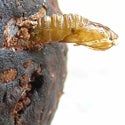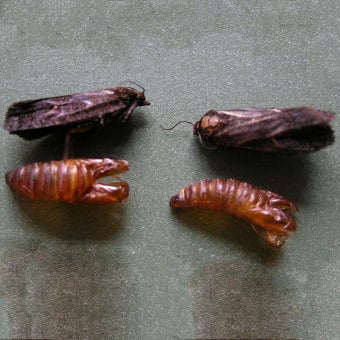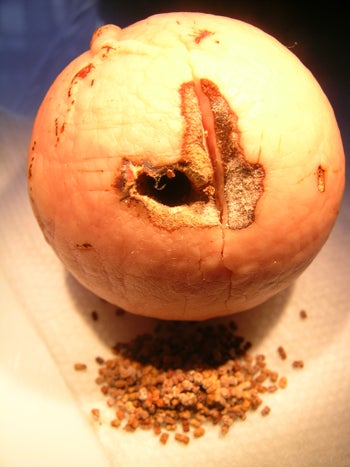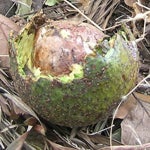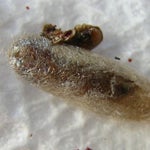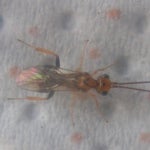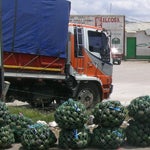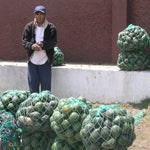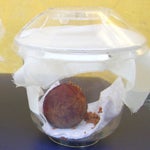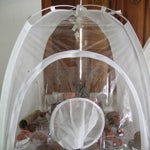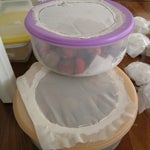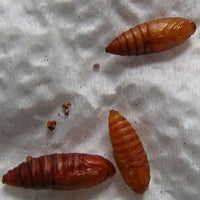Cryptaspasma sp. (Lepidoptera: Tortricidae: Olethreutinae)
Prepared by Mark Hoddle, Extension Specialist and Director of Center for Invasive Species Research
mark.hoddle@ucr.edu
Contents1 Introduction |
Introduction |
|
Figure 1. A Cryptaspasm sp. adult. |
|
Figure 2. The fruit of native species of Lauraceae in receiving areas (e.g., California bay laurel, Umbellularia californica [Lauraceae]) may also be at rick of attack by exotic Cryptaspasma sp. which could greatly affect the reproductive success and recruitment of vulnerable native plants in fragile natural systems. |
Cryptaspasma sp. Walsingham (Lepidoptera: Tortricidae) belongs to one of the most primative tribes in the sub-family Olethreutinae, the Microcorsini. This genus is composed of around 33 species that are found in the neotropics, thesoutheastern USA, Japan, eastern Russia, Africa, Madagascar, New Zealand, and Australia (Brown and Brown 2004). Very little is known about the ecology and biology of Cryptaspasma sp. Known food plants include acorns of Quercus spp., seeds of stone fruits, macadamia nuts, and fruit of aceitunillo (Aextoxicon punctatum [Aextoxicaceae]). In the Lauraceae, hosts include the fruit of Belschmiedia pendula, Persea borbonia (red bay), P. palustris (swamp bay), and P. americana (avocado) (Brown and Brown 2004).
Cryptaspasma sp. have been reared from avocado seeds collected in Puerto Rico, Mexico (Michoacán), and Guatemala. The pest status of Cryptaspasma spp. infesting avocado fruit in Mexico (i.e., C. lugubris) is uncertain as larvae have been found in seeds removed from fruit that had been collected from the ground. In Guatemala, C. sp. nr. lugubris (referred to hereafter as Cryptaspasma sp.) was reared from avocados collected across multiple locations. However, fruit picked from trees and collected from the ground at study sites in Guatemala was commingled making it impossible to determine of larvae had infested fruit hanging in trees or had attacked fruit lying on the ground.
However, this moth was reared from recently picked avocados that were being sold along the side of the road in Santiago Atitlan in Guatemala (see below).
Since Cryptaspasma sp. has been reared from fruit collected from the ground in Mexico (Brown and Brown 2004) this finding suggests one of two possibilities: (1) avocados lying on the ground and collected for rearing studies had been prematurely aborted because of larval feeding damage within fruit that were originally hanging on trees, or (2) Cryptaspasma sp. females only oviposit on avocado fruit that have dropped to the ground because of other reasons (e.g., strong winds caused fruit to fall off tree prematurely) or ovipositing females utilize bare avocado seeds that have been exposed once protective flesh has been removed (i.e., eaten by animals or rotted away).
Determining the pest status of Cryptaspasma spp. attacking avocados in countries exporting fruit is important for understanding the risk this insect poses to countries importing avocado fruit from areas that have endemic populations of this avocado seed feeding moth. Exotic Cryptaspasma spp. may pose an invasive threat to avocado industries in importing countries, such as California in the USA which receives imported avocados from Michoacán Mexico.
Pest Identification and Developmental Biology |
| Figure 3. Eggs of Cryptaspasma sp. laid on a clear smooth plastic cup. | Figure 4. Eggs laid on an avocado seed. | Figure 5. Eggs laid on the skin of a mature avocado fruit. |
| Figure 6. Cryptaspasma sp. larva on an avocado seed. | Figure 7. Larval tunneling damage to an avocado seed. | Figure 8. Mature larvae. |
|
Figure 9. A mature Cryptaspasma sp. larva forming its pupation cell between paper towels. |
Figure 10. The pre-pupal larva spinning a loose protective silk structure over the depression in the paper towel. | Figure 11. An empty pupal case of Cryptaspasma sp. Note "teeth" on the dorsal surface of the pupal case. |
Eggs and oviposition. The eggs of Cryptaspasma sp. are laid in masses and individual eggs are flat somewhat irregular in shape and white in color when first laid, but turn grey as larvae approach eclosion. Examination of the placement of 633 eggs in 30 randomly selected egg masses laid by Cryptaspasma sp. in the laboratory revealed that the average egg mass size was 21.10 ± 3.52 eggs (range 2 to 73 eggs), and that ~80% of eggs were laid on smooth plastic which included clear plastic cups and lids holding avocado seeds or fruit, and the floor and walls of the Bug-Dorm used for ovipositional studies. The remaining ~20% of eggs were distributed evenly across seeds and fruit in the cage. At 22.14°C ± 0.13 it took 10.78 ± 2.53 days for Cryptaspasma sp. eggs to hatch.
Larvae. Upon hatching, Cryptaspasma sp. larvae bore quickly through the skin of avocado fruit and tunnel into seeds where they complete larval development. Evidence of first instar larval tunneling into fruit is readily discerned by the detection of very fine "dust-like" frass on the outsides of fruit. Larvae emerging from eggs laid on plastic readily bore into clean avocado seeds that are adjacent to egg masses and a single avocado seed can support as many as 5-8 Cryptaspasma sp. larvae. In the laboratory at 22.14°C ± 0.13 it took Cryptaspasma sp. larvae around three weeks to complete development and emerge from seeds in search of pupation sites. Of 301 larvae reared on avocado seeds in the laboratory 72% reached adulthood.
Pupae. In the laboratory, mature Cryptaspasma sp. larvae readily formed pupal cells between layers of paper towel that line the floors of rearing boxes. Occassionally, larvae would force their way between layers of paper fibers that comprised a single sheet of paper towel and form pupal cells between the upper and lower sides of a piece of paper towel. At this stage of development, larvae are very sensitive to disturbance. Premature seperation of paper towels before the pupal case has been formed can result in larvae abandoning pupal chambers and commencing walking again. Larvae that were very close to pupating and unable to walk could die of dessication following the disturbance of the pupal chamber. The prepupal stage is variable in duration and may be affected by the fitness of the larva. Smaller malnourished larvae appear to take longer to form pupae in comparison to larger healthier larvae and smaller larvae may be more likely to die following disturbance. Approximately 95% of mature larvae would abandon avocado seeds to locate pupation sites, the remaining 5% of larvae would pupate within feeding tunnels in avocado seeds. Casual observations in the laboratory at 22.14°C ± 0.13 suggest that the sedentary prepupal stage lasts around 2-4 days (depending on the status of the larva) and the pupal stage is around 8 - 12 days in duration. When adult moths emerge, the pupal case is forcibly discharged from the pupal cell and will protrude from the margin of the pupal cell within which pupation occurred. Pupae are very sensitive to contact and vigorously flick the abdomen when disturbed or touched.
| Figure 12. Adult Cryptaspasma sp. with pupal cases. |
Adults. Adult Cryptaspasma sp. are dark grey moths that are almost black upon emergence. This dark coloration quickly fades as wing scales are lost during activity and wing venation becomes apparent. Under laboratory rearing conditions the sex ratio of Cryptaspasma sp. is 54% female. Adult females use pheromones to attract males. In the laboratory, female calling is easily recognized by rapid wing vibrating and the slight upturned end of the abdomen that has large pheromone glands protuding. Calling begins almost immediately following sunset and lasts for approximately one hour after which time all obvious locomotor activity by males and females ceases. At sunrise, adult moths rapidly seek dark concealed hiding places at ground level to rest. When provided access to 10% honeywater adult Cryptaspasma sp. live for around seven days at 22.14°C ± 0.13.
Feeding Damage and Biological Control Approaches |
|
Figure 13. Cryptaspasma sp. larvae feed internally on avocado seeds. |
Feeding damage. Cryptaspasma sp. larvae feed internally on avocado seeds. Extensive internal damage to seeds can result from larval activity and accumulations of frass appear at tunnel openings. Depending on the number of larvae feeding within a single avocado seed, Cryptaspasma sp. can almost completely excavate seeds internally leaving an empty shell. A diet of avocado seeds alone provides adequate nutrition for Cryptaspasma sp. larvae to complete development into fertile adult moths.
It is unknown whether Cryptspasma sp. larvae can feed and develop to maturity exclusively on a diet of avocado pulp. As part of a larger study to inventory avocado fruit feeding Lepidoptera in Guatemala, 6,740 avocados from 22 different sites were collected over a five month period. Fruit were held in Bug-Dorms until larvae living in fruit emerged and pupated. Fruit picked from trees and collected off the ground (previous work had indicated that infested fruit are likely to be prematurely aborted and upon abcission drop to the ground with larvae inside) were commingled from many sites making it impossible to determine if Cryptaspasma sp. larvae had infested hanging or dropped fruit. Studies are needed to ascertain whether Cryptaspasma sp. is a pest of hanging avocado fruit or strictly a specialist of dropped avocados. This was attempted in Guatemala through indirect studies investigating longevity of dropped avocados on the ground, the time required for Cryptaspasma sp. eggs to hatch under prevailing field conditions, and the rearing of Cryptaspasma sp. from purchased avocados recently picked from trees.
|
Figure 14. Mature avocados placed on the ground in a coffee plantation with an avocado tree overstorey. Cryptaspasma sp. had been reared from avocados collected from this site. After 3-6 days on the ground animals had consumed a significant amount of skin and fruit pulp. Any Cryptaspasma sp. eggs laid on the skin or exposed pulp of fruit would have been accidentally consumed before hatching. |
|
|
Figure 15. Pseudophanerotoma pupa. |
Figure 16. Adult Pseudophanerotoma parasitoid. |
Longevity of dropped avocados on the ground. Oviposition studies in the laboratory demonstrated that Cryptaspasma sp. would oviposit on avocado seeds and fruit (see photos above). However, the strength of any egg laying preferences as they may occur in the field as predicted from laboratory observations were overwhelmed because of the predilection of Cryptaspasma sp. for laying eggs on smooth plastic in the oviposition cage. Observations under field conditions of eight avocados placed on the ground in an avocado orchard indicated that skin and fruit pulp is almost entirely removed within ~12 days at ~18°C (average temperature at the field site) while it takes ~10 days for Cryptaspasma sp. eggs to hatch in the laboratory at ~22°C.
Assuming that Cryptaspasma sp. does lay eggs on the skin or pulp of dropped fruit in the field as indicated by laboratory results, it is reasonable to suggest that under prevailing field conditions the majority of these eggs would be consumed by animals eating dropped fruit on the ground before eggs had procured sufficient degree-days to hatch and for larvae to bore through fruit pulp before tunneling into protective seeds.
Therefore, laying eggs on the skin or pulp of dropped avocados lying on the ground would be appear to be a maladaptive reproductive strategy for Cryptaspasma sp. because of risk from accidental predation and may therefore be unlikely to occur. Eggs oviposited on exposed seeds on the ground would be at less risk of accidental predation by vertebrates consuming fruit and could be a viable reproductive strategy as rapid destructive seed consumption by vertebrates was not observed in the field.
Natural enemies of Cryptaspasma sp. One species of endoparasitoid, Pseudophanerotoma sp. (Hymenoptera: Braconidae: Cheloninae), was reared from ~30% of field collected Cryptaspasma sp. larvae. This is the first host record for aPseudophanerotoma sp. Members of the Cheloninae are generally egg-larval parasitoids of tortricoids and pyraloids.
Monitoring and Rearing Cryptaspasma |
Rearing of Cryptaspasma sp. from purchased avocados. Support for Cryptaspasma sp. ovipositing on avocados hanging in trees came from the purchasing of 354 fruit from a local roadside vendor who had harvested avocados from backyard trees in Santiago Atitlán on the day they were purchased. Examination of purchased fruit in the laboratory failed to detect any rotten, cracked, or otherwise damaged avocados (damage of this nature would have been indicative of fruit being damaged upon hitting the ground after dropping), which strongly suggested that these fruit had not been collected from the ground, and were recently picked from trees as claimed. Cryptaspasma sp. was reared from these purchased fruit suggesting that females had oviposited on fruit hanging in trees.
| Figure 17. Freshly picked fruit purchased from roadside vendors in Guatemala yielded Cryptaspasma sp. Purchased fruit were held in the laboratory for 14 days before seeds were extracted and held individually in ventillated rearing cups for larvae to emerge and pupate. | ||
Future studies to investigate the oviposition behavior of Cryptaspasma sp. in the field. The obvious way to determine if Cryptaspasma sp. is a pest of avocados hanging on trees is to harvest fruit directly from trees for rearing and not to commingle picked fruit with those collected from the ground. Direct fruit harvesting to address this question was attempted as part of this project on Cryptaspasma sp. in March 2007 but was unsuccessful. There were two possible reasons why Cryptaspasma sp. was not reared from picked fruit from sites that had yielded this moth from earlier surveys. First, by March when picked fruit surveys for Cryptaspasma sp. were initiated, the dry season in Guatemala was well underway and this climatic change was accompanied by a noticeable decrease in the collection of this moth (i.e., complete lack of detection). This seasonal transition was accompanied by an increase in the detection frequency of another seed feeding moth in fruit, Stenoma catenifer. Second, post priori analysis of collection data suggests that in addition to time of year, altitude may be important in determining the distribution of Cryptaspasma sp. in Guatemala. This tortricid was only reared from avocados that were collected at altitudes exceeding 1,300 m and it co-existed with S. catenifer up to 1,592 m, above 1,609 m only Cryptaspasma sp. was reared from avocados. Conversely, S. catenifer was reared from avocados grown in hot and humid conditions at sea level up to 1,592 m and the prevalence of this moth at higher altitude sites increased as the dry season progressed.
Establishing and maintaining a Cryptaspasma colony. Cryptaspasma sp. is very easy to rear in the laboratory. Adults mate readily and lay lots of eggs on smooth plastic surfaces. Larvae are voracious feeders of avocado seeds and are tolerant of high densities per seed. The developmental time from egg to reproductive adult in the laboratory at 22°C is quick at approximately five weeks.
| Figure 18. Ventilated food storage containers with clean avocado seeds (seed coat removed) were used for mass-rearing Cryptaspasma sp. larvae. Containers were lined with paper towel and larvae would pupate between layers of paper of towel. | |
Once adult moths have been reared from field collected avocados, introduce adult moths into a cage (e.g., commercially available Bug-Dorms [see photo] are perfect rearing cages for adult Cryptaspasma sp.) and supply adults with 10% honeywater in vials with cotton wicks that are suspended from the roof of the cage. Honeywater is a food source for adult moths and should be changed every five days as it begins to ferment. Provide clean avocado seeds and fruit to stimulate oviposition. Fruit should be thoroughly washed and dried to remove contaminants (e.g., dirt, predatory mites, scales, and mealy bugs) before introducing into the cage. Female Cryptaspasma sp. will oviposit on avcoado fruit and seeds (~20% of eggs are laid on these two substrates). Interestingly, female moths will preferentially lay most eggs (~80%) on smooth plastic, including the floor and clear plastic walls of the Bug-Dorm, and plastic cups and lids that are holding seeds or supporting fruit in a vertical position.
Oviposition Bug-Dorm used for Cryptaspasma sp. in Guatemala. Avocado seeds and fruit are positioned on the floor of the cage, plastic cups can be used to hold fruit and clean seeds, and egg crating positioned in the middle of the cage is excellent for holding fruit and seeds. Cryptaspasma sp. lay the majority of eggs on plastic cups. Eggs are also deposited on the floor and plastic walls (not on the ventilation mesh) of the Bug-Dorm. Eggs were occassionally laid on the honey water vials and the lids of the vials. Cardboard tubes and paper towel were placed on cages for shelter. Adult moths would literally dive to the bottom of cages to hide as soon as the sun entered through the windows of the laboratory. Turning on the laboratory lights at night would have the same effect on adults flying and walking in the Bug-Dorm.
|
Figure 19. Cryptaspasma sp. pupae removed from pupal cells between layers of paper towel. These pupae can be easiy sexed and divided for maintaining colonies or used for experiments. |
Every seven days remove fruit, seeds, and plastic cups and lids from cage. Replace with new fruit, seeds, and plastic cups and lids. Collect about 30-40 avocados each week from field sites. From these collected fruit the seeds can be extracted once fruit are fully mature and easy to crack open. Seeds must be cleaned, the pliable seed coat removed, stockpiled in a dry and well ventilated place (e.g., another Bug-Dorm), and used later as food for Cryptaspasma sp. larvae. With the removed fruit, seeds, and plastic cups from the oviposition Bug-Dorm do the following:
- Excise egg masses from plastic cups by using a hot knife to cut around the section of plastic with the eggs (do not cut too close to the egg mass or the heat from the knife melting the plastic may kill the eggs). Excised egg masses attached to plastic can be placed in rearing containers (i.e., large plastic food storage containers with ventilated lids) with clean avocado seeds and left to hatch. Larvae upon hatching will immediately burrow into seeds. Alternatively, eggs can be left in cups, avocado seeds added to the cup, and the cup closed with a ventilated lid. Line the floor of the rearing unit with paper towel as larvae will pupate between the layers of paper towel.
- Remove the avocado fruit and seeds with eggs from the oviposition cage and place in either a sealed ventilated container or another cage. Leave the fruit undisturbed for about 2 - 2.5 weeks. During this time the Cryptaspasma sp. eggs will hatch and the young larvae will burrow through the avocado pulp to the seed to start feeding. After 2 - 2.5 weeks crack open the fruit, extract the seed, clean (removing pulp by rubbing with paper towels is adquate - it is also useful to remove the seed coat at this stage as it is still moist and soft. Removal of the seed coat provides larvae direct access to the seed), and place in a ventilated container with two layers of paper towel. The larvae will continue to feed and develop within the cleaned seeds. Mature larvae will pupate between the layers of paper towel.
- Every week collect 85% mature avocado fruit to stimulate egg laying in the oviposition cage (about 6-8 fruit in the cage). All unused fruit should be opened when ripe and the seeds extracted and cleaned for feeding to young caterpillars.
- After 3-4 weeks mature Cryptaspasma sp. caterpillars will exit seeds and begin vigorous walking in the container for about 12 hrs. After this time the majority will hide between sheets of paper towel, form a pupal chamber, spin a protective silk structure, and begin to pupate. After an additional 48-96 hours pupae can be removed from ventilated containers and placed in the oviposition cage or seperated for use in experiments. Pupae are easily extracted by seperating layers of paper towel and mature pupae will drop out of the pupal chamber. Pupae can be gathered, sexed (based on whether the terminal segments of the ventral surface of the abdomen have a slit [female] or two obvious round protruberances [males]), and used for maintaining colonies or for experiments.
- After about 10 days pupae will finish development and the adult moths will emerge into the oviposition cage. The adults will mate and lay eggs in the cage and the cycle will repeat.
References |
- Brown, J. W. and R. L. Brown. 2004. A new species of Cryptaspasma Walsingham (Lepidoptera: Tortricidae: Olethreutinae) from Central America, the Caribbean, and southeastern United States, with a catalog of the world fauna of Microcorsini. Proc. Entomol. Soc. Wash. 106: 288-297.

